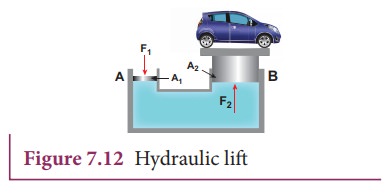Chapter: 11th Physics : UNIT 7 : Properties of Matter
PascalŌĆÖs law and its applications
PascalŌĆÖs
law and its applications
The
French scientist Blaise Pascal observed that the pressure in a fluid at rest is
the same at all points if they are at the same height. Statement of PascalŌĆÖs
law is If the pressure in a liquid is
changed at a particular point, the change is transmitted to the entire liquid
without being diminished in magnitude.
Application of PascalŌĆÖs law
Hydraulic
lift

A
practical application of PascalŌĆÖs law is the hydraulic lift which is used to
lift a heavy load with a small force. It is a force multiplier. It consists of
two cylinders A and B connected to each other by a horizontal pipe, filled with
a liquid (Figure 7.12). They are fitted with frictionless pistons of cross
sectional areas A1 and A2 (A2 > A1).
Suppose a downward force F is applied on the smaller piston, the pressure of
the liquid under this piston increases to P(where, p=F1/A1).But
according to PascalŌĆÖs law, this
increased pressure P is transmitted undiminished in all directions. So a
pressure is exerted on piston B. Upward force on piston B is

Therefore
by changing the force on the smaller piston A, the force on the piston B has
been increased by the factor A1/A2 and this factor is
called the mechanical advantage of the lift.
EXAMPLE 7.7
Two
pistons of a hydraulic lift have diameters of 60 cm and 5 cm. What is the force
exerted by the larger piston when 50 N is placed on the smaller piston?
Solution
Since,
the diameter of the pistons are given, we can calculate the radius of the
piston

This
means, with the force of 50 N, the force of 7200 N can be lifted.
Related Topics